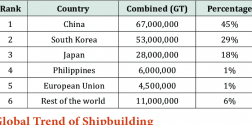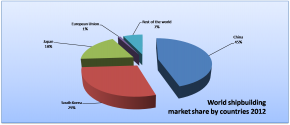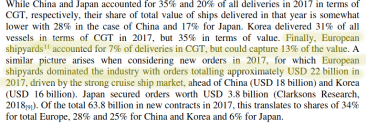Question: what's got to do with CV-XX(003) thread?When America had a dominant shipbuilding industry American commercial shipyards were also used for military ships. The reason that’s not the cast today isn’t because America deliberately siloes its military and commercial industries but because they no longer have a commercial ship building industry.
You are using an out of date browser. It may not display this or other websites correctly.
You should upgrade or use an alternative browser.
You should upgrade or use an alternative browser.
CV-18 Fujian/003 CATOBAR carrier thread
- Thread starter Jeff Head
- Start date
Idk. Last time I checked, Europe had a sizeable share of the world's cruise ship construction. The biggest cruise ships in the world were/are built in Saint-Nazaire at Chantiers de l'Atlantique shipyard in France.To begin with, neither Europe nor US have any meaningful civilian shipbuilding business. So their separation is merely because they don't have many civilian ship to build.
The Mistral class LHD's were built at that shipyard, but in separate facilities. The same applies to the Damen Group, in the Netherlands. The Rotterdam class LPD's were built at a dedicated naval shipyard, as were De Zeven Provincien class frigates and many other naval vessels.
This one is easy.Question: what's got to do with CV-XX(003) thread?
Answer: Nothing
I will only pay attention to the politics of ship building when US finds away to sanction Chinese ship-building industry to death just like how they are doing with Huawei and Chinese fab industries thus unintendingly creating a global shortage that might last some years. But I don't think Chinese ship industries uses any American tech so no blacklisting options or sanctions for the US in this situation.
The Hegemon can always sanction anyone doing business with Chinese shipyardsThis one is easy.
Answer: Nothing
I will only pay attention to the politics of ship building when US finds away to sanction Chinese ship-building industry to death just like how they are doing with Huawei and Chinese fab industries thus unintendingly creating a global shortage that might last some years. But I don't think Chinese ship industries uses any American tech so no blacklisting options or sanctions for the US in this situation.
steve_rolfe
Junior Member
When is this thread going to focus back on to the 003 Carrier?
I would not have replied to you because we are being off-topic. But it seems that you are living in another planet.Idk. Last time I checked, Europe had a sizeable share of the world's cruise ship construction. The biggest cruise ships in the world were/are built in Saint-Nazaire at Chantiers de l'Atlantique shipyard in France.
The Mistral class LHD's were built at that shipyard, but in separate facilities. The same applies to the Damen Group, in the Netherlands. The Rotterdam class LPD's were built at a dedicated naval shipyard, as were De Zeven Provincien class frigates and many other naval vessels.
Let's also NOT use a niche product (cruise ship) to represent the full picture. How many cruise ship is produced a year? I have to ask, are you deliberately picking a 1% work of the whole market to support your point?
I must say it again since our last "confrontation". I find that you seem to repeatedly employing tactics to avoid admitting loose or acknowledge others having a right point. By doing so you would/could either drag others into off-topic meaningless argument, or make others feeling guilty of derailing the thread and give up refuting your false. I don't want either of these, so I choose to put you in my ignore list. You have the stage to yourself
market share in 2014

2012
In this article
EU has 1%, USA does not have its name in the chart.

I wasn't the one making the comparison to Boeing.
The CSIS article pointed out that the same facilities within Chinese shipyards are used for the construction of military vessels and commercial vessels, while that is not the case in Europe or the US.That makes for an easy argument to claim that foreign parties doing business with those shipyards are directly supporting China's naval construction program. That's about it.
For the most part, they are separated. For example, Jiangnan's famed fitting pool where we see destroyers were fitted has been mostly military and government vessels, along with smaller commercial ships for Chinese lines. This fitting pool is too small for many commercial ships nowadays. A shipyard in Wuhan specializes in submarines, and so is the shipyard in Bohai. Huangpu Shipyard has a divide section where one place makes the military, coast guard and government vessels, while another shipyard is purely commercial.
The main and only exception has been the carriers because they require the huge drydocks traditionally for massive commercial ships. The drydock where 003 is sitting right now, has never been used with a warship, and its only has been used with container ships. You can say, this drydock is "borrowed" for that purpose. None of China's massive drydocks were made purposely for building carriers. The commercial drydocks were borrowed for the purpose of making carriers only. But anything smaller, destroyers, frigates, and submarines, they always had specialized shipyards.
This is also true of the Dalian shipyard drydock that the Liaoning had its transformative refit from the Varyag and where Shandong was built. That drydock was borrowed and since then it has returned to making commercial ships, namely tankers. That drydock is not even close to being the biggest in Dalian, the biggest of which is 700 meters long and is partnered with Kawasaki Heavy Industries.
For a country that has at one time, as many as 3000 shipyards in its peak, the vast majority of these shipyards build only civiilan or commercial ships. I say peak because the number of China's shipyards have declined due to shipbuilding glut and because of real estate development. You make bundles more money selling older shipyards for real estate developers than operate in a loss or razor thin margins building ships year after year.
For the most part it certainly this is the case of Europe, as Fincantieri makes cruise ships and ferries, also makes FREMM and owns the Marinette shipyards that make the Freedom class LCS and the Constellation class frigates. Thyssenkrupp makes both civilian and military vessels, and they also make elevators. For CSIS to miss the obvious in their report is dope.
Daewoo, Hyundai, Samsung, Inabari and Mitsubishi all have civilian and military production. This is all common knowledge and for a long time already. Oh, and France's Naval Group? They also make high end billionaire yachts. What about Austal, whose US subsidiary make Independence class LCS and other naval vessels? In Australia they make all sorts of civilian and commercial catamarans, from high end yachts to ferries. Do they care? Does it matter? Taiwan's Evergreen shipping line has standing orders with Jiangnan Shipyard for container ships. Japan's MOL has orders with Hudong Zhonghua and COSCO has orders with Japan's Imabari.
The commercial shipping line and ship building industry for the longest time has lived in their own highly globalized world and it works for them. The epitome of globalization is in the shipping and shipbuilding business. The building of flagship commercial vessels, such as the largest of box ships, bulkers, tankers, various gas and LNG carriers, have become so specialized that European ship liners, which are still the largest in the world, source all their ships in the Far East, making multiple orders in China, Japan and S. Korea. European shipbuilders have concentrated in cruise ships, ferries and yachts. Japan has already gotten into the cruise ship business, namely for Princess Cruise lines, and you should know their names because of the pandemic. China is increasingly doing cruise ships, although not as big or high end as the Europeans. Their first high end cruise ship is a replica of the Titanic with a Chinese shipyard that happens to be in partnership with an Australian billionaire and company.
Last edited:
I am sorry. You claimed that Europe has no meaningful civilian shipbuilding. I provided you one example of a rather meaningful product where Europe has been historically strong. The latest cruise ships built in Europe rival in size (228k GT vs 236k GT) those gigantic LNG powered container ships we saw in the CSIS photos together with the Type 003 carrier. Just one shipyard in Germany has fully enclosed dry docks large enough to assemble 3 ultra size cruise ships simultaneously all the while tucked away from prying eyes.Let's also NOT use a niche product (cruise ship) to represent the full picture. How many cruise ship is produced a year? I have to ask, are you deliberately picking a 1% work of the whole market to support your point?
Your claim of 1% does not correspond to any numbers I've seen, neither in delivered CGTs nor in dollar value of delivered ships. The table you posted doesn't even add up percentage wise with the GT values in the column to the left.
According to a , for the year 2017, European shipyards had a 7% share of the world market in terms of delivered CGTs, but a 13% in terms of dollar value of delivered ships:

Not sure what you problem is. I replied to a post by @PiSigma, and offered my interpretation of the linked CSIS article. You wilfully engaged in off-topic discussion just as we did.I must say it again since our last "confrontation". I find that you seem to repeatedly employing tactics to avoid admitting loose or acknowledge others having a right point. By doing so you would/could either drag others into off-topic meaningless argument, or make others feeling guilty of derailing the thread and give up refuting your false. I don't want either of these, so I choose to put you in my ignore list.
The point in the article was that foreign companies who order ships from the named Chinese shipyards, directly support China's naval construction program. This is because those shipyards use the same facilities to build civilian and naval vessels. In case of Europe, I gave two examples of large shipbuilders that separate their civilian and naval construction in terms of facilities or even shipyards (Damen) that are used. Instead of focusing on percentages of the world market, you could've instead demonstrated shipyards in Europe that don't make this separation and thereby refuted the point made in the article.
Moderator: sorry for going off-topic again after your issued a warning, but I had to reply to save my face
I am sorry. You claimed that Europe has no meaningful civilian shipbuilding. I provided you one example of a rather meaningful product where Europe has been historically strong. The latest cruise ships built in Europe rival in size (228k GT vs 236k GT) those gigantic LNG powered container ships we saw in the CSIS photos together with the Type 003 carrier. Just one shipyard in Germany has fully enclosed dry docks large enough to assemble 3 ultra size cruise ships simultaneously all the while tucked away from prying eyes.
Your claim of 1% does not correspond to any numbers I've seen, neither in delivered CGTs nor in dollar value of delivered ships. The table you posted doesn't even add up percentage wise with the GT values in the column to the left.
According to a , for the year 2017, European shipyards had a 7% share of the world market in terms of delivered CGTs, but a 13% in terms of dollar value of delivered ships:
View attachment 69304
Not sure what you problem is. I replied to a post by @PiSigma, and offered my interpretation of the linked CSIS article. You wilfully engaged in off-topic discussion just as we did.
The point in the article was that foreign companies who order ships from the named Chinese shipyards, directly support China's naval construction program. This is because those shipyards use the same facilities to build civilian and naval vessels. In case of Europe, I gave two examples of large shipbuilders that separate their civilian and naval construction in terms of facilities or even shipyards (Damen) that are used. Instead of focusing on percentages of the world market, you could've instead demonstrated shipyards in Europe that don't make this separation and thereby refuted the point made in the article.
Moderator: sorry for going off-topic again after your issued a warning, but I had to reply to save my face. Please move this discussion to the shipbuilding industry thread. Thank you.
Damen makes their warships and smaller commercial vessels in the same drydocks. Bigger drydocks are reserved for bigger ships, which are commercial. Size is the separator for military ships vs. commercial ships, with military ships being much smaller than a commercial ship, and therefore bigger drydocks are reserved for commercial ships and smaller drydocks for smaller ships including military. This is merely business and rational allocation of resource.
If Europe, S. Korea or Japan is going to make a 320 meter long aircraft carrier, they would obviously borrow a drydock used to make a mega boxship or cruise ship.
The last time the US made a super tanker, they used the same drydock used for the aircraft carriers. That's why the US exited out of the business. Priorities.
Last edited:
